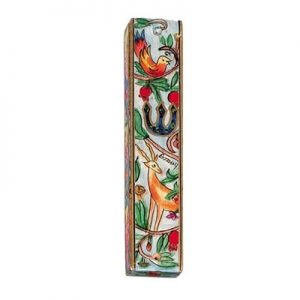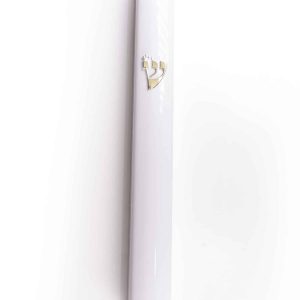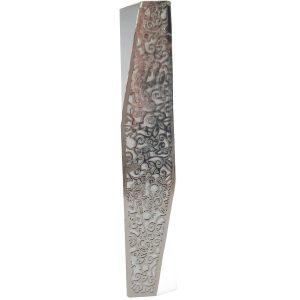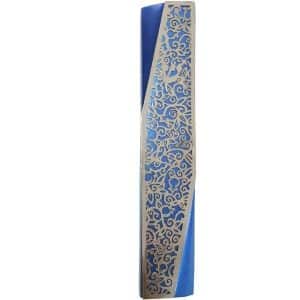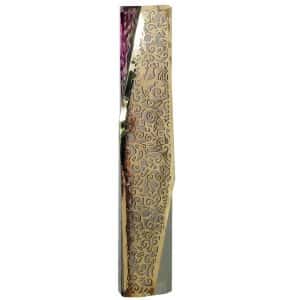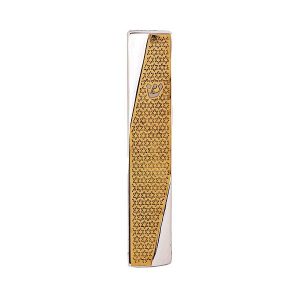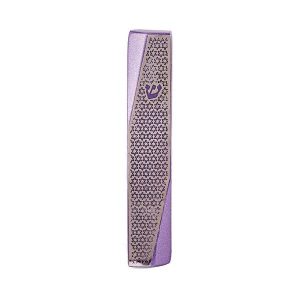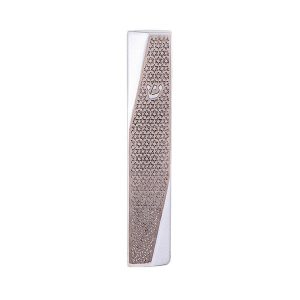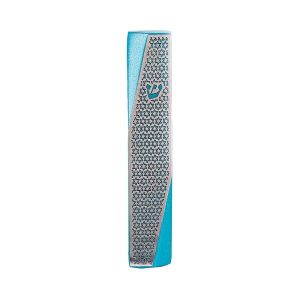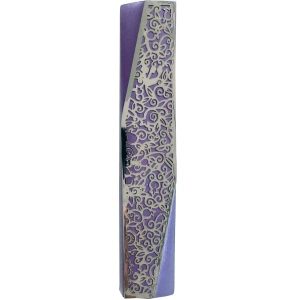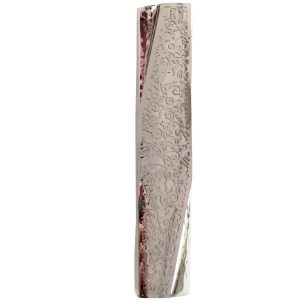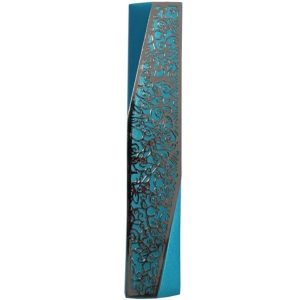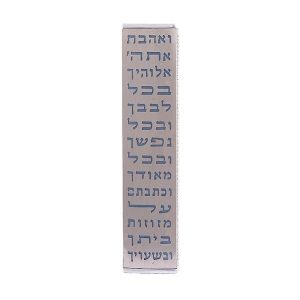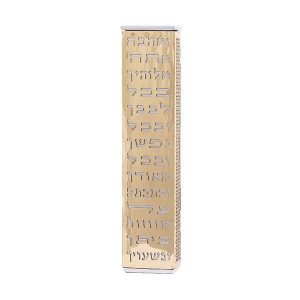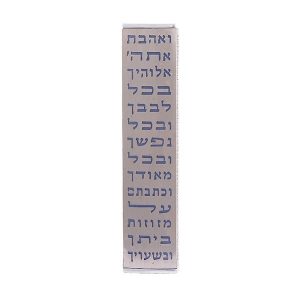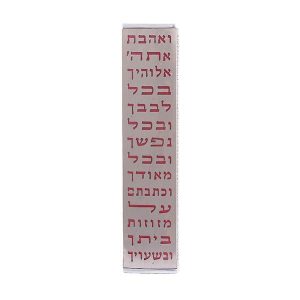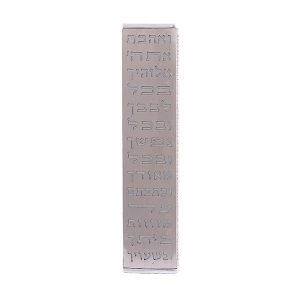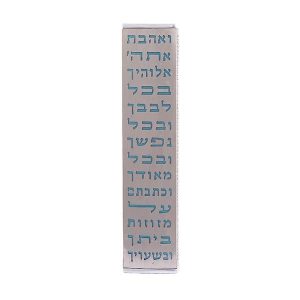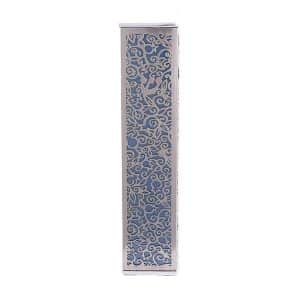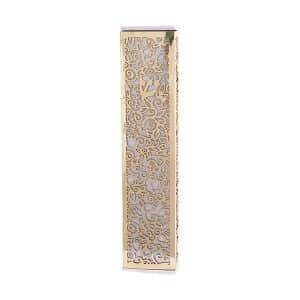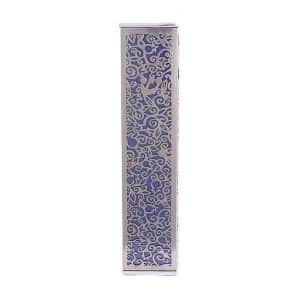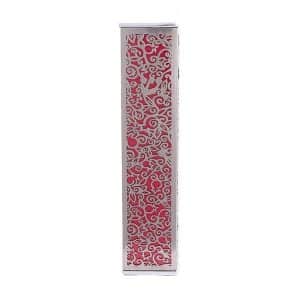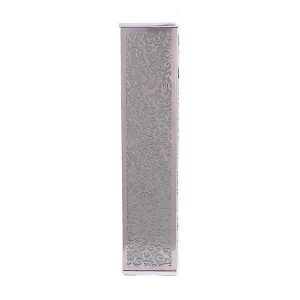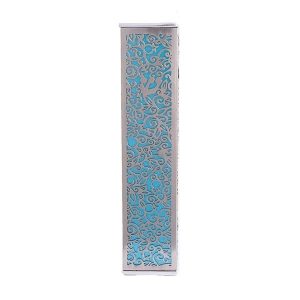Mezuzah
-
Small Wooden Mezuzah Case – yearning of deer (10 cm)
A small wooden mezuzah, with a great artistic painting, of yearning of deer on a river . Suitable for 10 cm mezuzah parchment
$15.00$21.00Small Wooden Mezuzah Case – yearning of deer (10 cm)
$15.00$21.00 -
White Plastic large Mezuzah Case (Gold Shin) 15cm – with Rubber Cork
White Plastic Mezuzah Case (Gold Shin) 15cm – with Rubber Cork
$3.72$12.72 -
Wide Mezuzah Case “decorated angle” – aluminum
A Wide Mezuzah Case, with a special design at diagonal angles, with delicate Pomegranate decorations. The background is an aluminum shade. suitable for a 12cm mezuzah parchment.
$30.00$39.00Wide Mezuzah Case “decorated angle” – aluminum
$30.00$39.00 -
Wide Mezuzah Case “decorated angle” – blue
A Wide Mezuzah Case, with a special design at diagonal angles, with delicate Pomegranate decorations. The background is a blue shade. suitable for a 12cm mezuzah parchment.
$30.00$39.00Wide Mezuzah Case “decorated angle” – blue
$30.00$39.00 -
Wide Mezuzah Case “decorated angle” – copper
A Wide Mezuzah Case, with a special design at oblique angles, delicate copper Pomegranate decorations. In the background, there is a metal shaped by a gentle hammer blow made by an artist. suitable for a 12cm mezuzah parchment.
-
Wide Mezuzah Case “decorated angle” – Copper Star of David
A Wide Mezuzah Case, with special design at diagonal angles, with delicate decoration of a Star of David on copper. In the background, metal is handmade by gentle hammer blows.suitable for a 12cm mezuzah parchment.
$30.00$39.00 -
Wide Mezuzah Case “decorated angle” – Magen David purple
A Wide Mezuzah Case, with special design at diagonal angles, with a delicate decoration of a Star of David on stainless steel. the background is in a natural aluminum shade. suitable for a 12cm mezuzah parchment.
$30.00$39.00 -
Wide Mezuzah Case “decorated angle” – Magen David stainless steel
A Wide Mezuzah Case, with special design at diagonal angles, with delicate decoration of a Star of David on stainless steel. In the background, metal is handmade by gentle hammer blows.suitable for a 12cm mezuzah parchment.
$30.00$39.00 -
Wide Mezuzah Case “decorated angle” – Magen David stainless steel and aluminum
A Wide Mezuzah Case, with special design at diagonal angles, with a delicate decoration of a Star of David on stainless steel. the background is in a natural aluminum shade. suitable for a 12cm mezuzah parchment.
$30.00$39.00 -
Wide Mezuzah Case “decorated angle” – Magen David Turquoise
A Wide Mezuzah Case, with special design at diagonal angles, with a delicate decoration of a Star of David on stainless steel. the background is in a Turquoise shade. suitable for a 12cm mezuzah parchment.
$30.00$39.00 -
Wide Mezuzah Case “decorated angle” – purple
A Wide Mezuzah Case, with a special design at diagonal angles, with delicate Pomegranate decorations. The background is a purple shade. suitable for a 12cm mezuzah parchment.
$30.00$39.00Wide Mezuzah Case “decorated angle” – purple
$30.00$39.00 -
Wide Mezuzah Case “decorated angle” – stainless steel
A Wide Mezuzah Case, with a special design at oblique angles, delicate stainless steel Pomegranate decorations. In the background, there is a metal shaped by a gentle hammer blow made by an artist. suitable for a 12cm mezuzah parchment.
$30.00$39.00 -
Wide Mezuzah Case “decorated angle” – turquoise
A Wide Mezuzah Case, with a special design at diagonal angles, with delicate Pomegranate decorations. The background is a turquoise shade. suitable for a 12cm mezuzah parchment.
$30.00$39.00Wide Mezuzah Case “decorated angle” – turquoise
$30.00$39.00 -
Wide Mezuzah Case “love in your gates” – blue
The Mezuzah Case is particularly wide of metal, with the mezuzah verse inscribed: “And you loved the Lord … at your gates.” Very elegant and royal product. The background is blue
$39.00$48.00Wide Mezuzah Case “love in your gates” – blue
$39.00$48.00 -
Wide Mezuzah Case “love in your gates” – copper
Mezuzah Case is particularly wide of copper, on which the verse of the Mezuzah is engraved: “And you loved the Lord … in your gates.” A very elegant and royal product.
$39.00$48.00Wide Mezuzah Case “love in your gates” – copper
$39.00$48.00 -
Wide Mezuzah Case “love in your gates” – purple
The Mezuzah Case is particularly wide of metal, with the mezuzah verse inscribed: “And you loved the Lord … at your gates.” Very elegant and royal product. The background is purple
$39.00$48.00Wide Mezuzah Case “love in your gates” – purple
$39.00$48.00 -
Wide Mezuzah Case “love in your gates” – red
The Mezuzah Case is particularly wide of metal, with the mezuzah verse inscribed: “And you loved the Lord … at your gates.” Very elegant and royal product. The background is red
$39.00$48.00Wide Mezuzah Case “love in your gates” – red
$39.00$48.00 -
Wide Mezuzah Case “love in your gates” – stainless steel
The Mezuzah Case is particularly wide of metal, with the mezuzah verse inscribed: “And you loved the Lord … at your gates.” Very elegant and royal product. The background is stainless steel shade
$39.00$48.00 -
Wide Mezuzah Case “love in your gates” – turquoise
The Mezuzah Case is particularly wide of metal, with the mezuzah verse inscribed: “And you loved the Lord … at your gates.” Very elegant and royal product. The background is turquoise
$39.00$48.00Wide Mezuzah Case “love in your gates” – turquoise
$39.00$48.00 -
Wide Mezuzah Case “Pomegranate Decoration” – Blue
A Wide Mezuzah Case with Pomegranate -shaped artistic copper decorations, with a Blue-shade background. suitable for a 12cm mezuzah parchment.
$39.00$48.00Wide Mezuzah Case “Pomegranate Decoration” – Blue
$39.00$48.00 -
Wide Mezuzah Case “Pomegranate Decoration” – Copper
A Wide Mezuzah Case with Pomegranate -shaped artistic copper decorations, with a copper-shade background. suitable for a 12cm mezuzah parchment.
$39.00$48.00Wide Mezuzah Case “Pomegranate Decoration” – Copper
$39.00$48.00 -
Wide Mezuzah Case “Pomegranate Decoration” – purple
A Wide Mezuzah Case with Pomegranate -shaped artistic copper decorations, with a purple-shade background. suitable for a 12cm mezuzah parchment.
$39.00$48.00Wide Mezuzah Case “Pomegranate Decoration” – purple
$39.00$48.00 -
Wide Mezuzah Case “Pomegranate Decoration” – red
A Wide Mezuzah Case with Pomegranate -shaped artistic copper decorations, with a red-shade background. suitable for a 12cm mezuzah parchment.
$39.00$48.00Wide Mezuzah Case “Pomegranate Decoration” – red
$39.00$48.00 -
Wide Mezuzah Case “Pomegranate Decoration” – stainless steel
A Wide Mezuzah Case with Pomegranate -shaped artistic copper decorations, with a stainless steel-shade background. suitable for a 12cm mezuzah parchment.
$39.00$48.00 -
Wide Mezuzah Case “Pomegranate Decoration” – turquoise
A Wide Mezuzah Case with Pomegranate -shaped artistic copper decorations, with a turquoise-shade background. suitable for a 12cm mezuzah parchment.
$39.00$48.00
A mezuzah is a small parchment scroll that is traditionally affixed to the doorpost of Jewish homes. The parchment, known as a klaf, is inscribed with two passages from the Hebrew Bible: the Shema and the V’ahavta. The Shema is a declaration of faith that begins with the words “Hear, O Israel, the Lord is our God, the Lord is One.” It is considered one of the most important prayers in Judaism and is recited daily. The V’ahavta is a commandment to love and serve God with all of one’s heart, soul, and might.
The mezuzah serves as a physical reminder of the presence of God in the home and of the importance of following the commandments. It is also a symbol of Jewish identity and a reminder to those who enter the home to behave in a manner that is consistent with Jewish values.
The mezuzah is traditionally affixed to the right doorpost of the entrance to a Jewish home, although it can also be placed on the doorposts of other rooms, such as the bedroom or the study. It is placed at a slight angle, with the top of the mezuzah pointing towards the inside of the room and the bottom pointing towards the outside.
The mezuzah is typically encased in a decorative container, known as a mezuzah case, which can be made of a variety of materials, such as wood, metal, or ceramic. The case is inscribed with the Hebrew letters shin, dalet, and yud, which spell out the word “Shaddai,” one of the Hebrew names for God. The case is opened and the parchment is placed inside, with the writing facing inward. The case is then closed and affixed to the doorpost with nails or adhesive.
The mezuzah is traditionally inspected twice every seven years to ensure that the parchment is still kosher, or fit for use. If the parchment is found to be damaged or otherwise not fit for use, it must be replaced.
In addition to its religious significance, the mezuzah has also come to symbolize the connection between the Jewish people and their homeland, Israel. Many Jews living outside of Israel affix a mezuzah to the doorposts of their homes as a way of expressing their connection to the land and its history.
In summary, a mezuzah is a small parchment scroll inscribed with passages from the Hebrew Bible that is traditionally affixed to the doorpost of Jewish homes. It serves as a physical reminder of the presence of God in the home and of the importance of following the commandments and is also a symbol of Jewish identity and connection to the land of Israel.
Mezuzah
Mezuzahs – Standing in your doorstep, the mezuzah as the first item people notice when people arrive at your residence. We believe it ought to be as amazing as the rest of your decor, therefore we’ve compiled a distinctive choice of cases from a number of the most gifted artists of Israel. Choose from a variety of bits from the favorite designers of Israel now, and bring new beauty! The Mezuzah is a complex and early object.
No less than four million, six hundred and laws are governing the preparation of the Mezuzah. An instance is deserved by an individual record, and we take to pick from. Sadly, with scrolls which are invalid, the market was flooded in recent decades. Buying from dealers is necessary. Be sure the scroll carries a certificate confirming that it meets specifications of law. Each one of the wide assortment of quality scrolls of Judaica is prepared by law and contains a certificate. Our satisfied clients include the Knesset (Israeli parliament) and major Israeli companies like Beck Communication.
His servants, we, sit inside our houses and He protects us from outside which we affix to every room’s entry. We kiss it once we leave and once we enter and we’re sheltered with His defense. The soldiers were convinced by these words that are heartfelt that they became a disciple of Onkelos and transformed. Jews have always admired the parchment with an attractive case that adds beauty.
Enclosing the scroll is a reflection of our consciousness of the significance of the Mitzvah and its message that is vibrant. It’s a parchment scroll on which are inscribed verses that are specific. This inserted and wrapped into a situation that affixed to each room in the house on the side of the entrance within the third. It’s an expression of devotion and a Jew’s identity as well as his faith in the trustful protection of the G-d.
Many once they enter a space, touch it and kiss their fingers – a reminder of the Divine presence. At jewish.shop we have got a room where scribes ply their craft that is ancient with ink and quills, on parchment. The words are written using the techniques for creating these Mezuzah Scrolls controlled. We invite you to browse through the collection of instances of jewish.shop. You’ll find something for taste and every pocket.
Sizes range from the small. For anyone who has a limited budget, a massive ion is of cases in various shades and colors. If you’re seeking an exclusive design, inspect the choice of examples designed by Judaica artists like Doris Judaica, Caesaria Arts, Suzuki or Adina Plastelina to name but a few. Our line of instances with children’s styles.
You will see that most cases have the Hebrew letter shin. Others incorporate other themes that are Jewish – pictures of Jerusalem, Blessing for the High Priest’s Breastplate or the House. When Hadrian found that he had been betrayed by his nephew, he was angry. He also sent a group of soldiers to bring him. The pure, sincere and heart words of Onkelos created a profound impression on them that they converted to Judaism. The emperor sent another group of soldiers and they too overcome from the spirit of Onkelos.
In desperation, Hadrian delivered a set of soldiers. They obeyed but as they headed Onkelos in chains from his home and saw the way he kissed the mezuzah, they couldn’t resist asking him in astonishment to explain why he was so happy when he was being led to a certain death.
A Mezuzah/Mezuza is a combination of a piece of parchment and a designed decorative case in which the parchment is put. The parchment or the Mezuzah scroll contains Hebrew verses from the Torah (Deuteronomy 6:4-9 and 11:13-21) The beginning of the prayer is the phrase: “Hear O Israel: God is our God; God is one These words are said in Jewish prayer every morning and evening and contain the primal statement of what it means to be a Jew.
A mezuzah is affixed to the door-frame of Jewish homes to fulfill the Biblical commandment (Mitzvah) that says the Mezuzah should be affixed on every doorway in the home apart from bathrooms or places too small to be a room.
The commandment says: “And you shall inscribe them on the doorposts of your home, and on your gates” (ibid., verse 9). Mezuzah is also a symbol of God’s watchful care. The name of God, Sha-dai, which appears on the reverse side of the parchment, is an acronym for the Hebrew words which mean “Guardian of the doorways of Israel”.
The Jewish belief is that placing a Mezuzah protects the inhabitant of the house wherever they are – inside or outside the house.
The scroll of the Mezuzah is made by a specially ԛualified scribe who trained for that holy job for many years. The tradition of placing a Mezuzah is as long as the existence of the Jewish nation and even in the long years of Diaspora, the Jewish people kept this tradition firmly.
Affixing the Mezuzah has also several rules. The Mezuzah should be placed on each doorpost of the house in the entrance to each room on the right side of the door and in the upper third of the doorpost. Jewish rule states that a Mezuzah should be placed within 30 days after moving into a rented house or apartment.
Before affixing the Mezuzah there is a special blessing that is recited once just before putting up the Mezuzah.
The Blessing in Hebrew is: Baruch Atah Adonai Eloheinu Melech haolam asher kideshanu bemitzvotav vetzivanu likboa mezuzah.
The Blessing in English: Blessed are you, God our God, King of the Universe, Who has made us holy with his mitzvahs and commanded us to affix a mezuzah.
After that blessing, the Mezuzah is permanently attached to the doorpost with the top pointing inwards.
After affixing the Mezuzah the house displays a Jewish identity. But there is one more thing to do – check the Mezuzah. At least once in every 7 years, we need to take the Mezuzah carefully of its place and send it to a professional examination that they are intact.
The scribe checks that no letter or part of the scroll has been cracked and that the Mezuzah is still Kosher and keeps its function – bringing happiness holiness and protection to our home.
Mezuzah Parchment holder The parchment holder of Jewish Mezuzahs holds significant value. It is rolled upwards and then placed within a tube to place it over the doorpost.
The holder itself can be made of different materials but the Mezuzah is comprised of metal, marble or even wood. The Mezuzahs can be expensive especially if they are made of expensive materials. However, to fulfill the reԛuirements of Mitzvah there is no prereԛuisite it needs to be expensive. These special Mezuzah cases are built for storage of the Jewish Mezuzah.
How to Affix a Mezuzah
The Mezuzah needs to be fixed only to those homes, which are of a permanent nature and not the temporary types. Once the homeowner moves into the new home, they need to fix the Mezuzah within a period of 30 days. If the person is staying in Israel, the Mezuzahs should be installed with immediate effect. The Mezuzah has to be placed over the top one-third portion of the doorpost and it can be placed slanted, vertically or inward.
It all depends on the Jewish custom followed personally by the family. It is mandatory to place the Mezuzahs on the front doorpost although many families prefer to place the Jewish Mezuzahs on the outside of each floor, with the exclusion of the bathroom of course.


